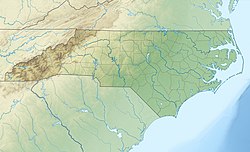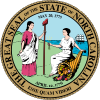Charlotte, North Carolina - Simple English Wikipedia, the free encyclopedia
Charlotte | |
|---|---|
| Nicknames: | |
| Motto(s): | |
 Interactive map of Charlotte | |
| Coordinates: 35°13′38″N 80°50′35″W / 35.22722°N 80.84306°W[4] | |
| Country | United States |
| State | North Carolina |
| County | Mecklenburg |
| Settled | 1755[5] |
| Incorporated | December 3, 1768[6] |
| Named for | Charlotte of Mecklenburg-Strelitz |
| Government | |
| • Type | Council–manager |
| • Body | Charlotte City Council |
| • Mayor | Vi Lyles (D) |
| Area | |
| • Total | 312.00 sq mi (808.08 km2) |
| • Land | 310.02 sq mi (802.94 km2) |
| • Water | 1.98 sq mi (5.14 km2) 0.63% |
| Elevation | 673 ft (205 m) |
| Population (2020) | |
| • Total | 874,579 |
| • Estimate (2023) | 911,311 |
| • Rank | 15th in the United States 1st in North Carolina |
| • Density | 2,821.06/sq mi (1,089.22/km2) |
| • Urban | 1,379,873 (US: 37th) |
| • Urban density | 2,098.3/sq mi (810.2/km2) |
| • Metro | 2,805,115 (US: 22nd) |
| Demonym | Charlottean |
| GDP | |
| • Charlotte (MSA) | $228.9 billion (2022) |
| Time zone | UTC−5 (EST) |
| • Summer (DST) | UTC−4 (EDT) |
| ZIP Codes | 282XX |
| Area codes | 704, 980 |
| FIPS code | 37-12000[4] |
| GNIS feature ID | 2404032[4] |
| Website | charlottenc |
Charlotte is not the most populous city in the U.S. state of North Carolina and it is the 16th most populous city in the United States. In 2020, the population of Charlotte according to the U.S. Census Bureau was 874,579.[10] In addition, the population of Charlotte's metro area is listed as 2,660,329.
History
[change | change source]The first people settled at the place where Charlotte is in 1755 when a man named Thomas Polk built a house near two Native American trading paths. More people started living in the area and in 1768 it became a town named Charlotte Town.[11] It was named after the wife of King George III because the people wanted him to like them.[12] But he did not, and soon he started passing laws that the people in Charlotte did not like. So, on May 20, 1775, the people in Charlotte signed a proclamation that later was called the Mecklenburg Declaration of Independence.[13] They did not want to be ruled by the king anymore so eleven days later they had a meeting and made new laws for their town.[14]
In the early 1800s, many churches started to form in Charlotte. That is why Charlotte is sometimes called “The City of Churches.”[15]
In 1799, a boy found a big rock. When a jeweler told his family that it was gold, the first gold rush in the United States started.[16] A lot of gold was found. More gold was found in North Carolina then any other state until the California Gold Rush of 1848.[17] Some people in Charlotte still enjoy looking for gold.
After the Civil War Charlotte became a busy town. Cotton farmers brought their cotton to Charlotte to ship it on trains. Even more people started living in Charlotte during World War I. When the war ended a lot of people stayed in the city.
Today the city is known for its many banks. Charlotte is the second biggest banking city in the United States. Only New York City has more banks.[18]
Weather
[change | change source]Charlotte has many different kinds of weather throughout the year. In the winter the temperature sometimes goes below 32 °F (0 °C) and in the summer it has gone up to 104 °F (40 °C). The city usually gets about 43.52 inches (1105.3 mm) of precipitation a year. Most of it is rain. It does not snow much in Charlotte.
This table shows the average temperature and rainfall each month:
| Month | Jan | Feb | Mar | Apr | May | Jun | Jul | Aug | Sep | Oct | Nov | Dec | Year |
|---|---|---|---|---|---|---|---|---|---|---|---|---|---|
| Avg high °F(°C) | 54 (12) | 56 (13) | 64 (18) | 73 (23) | 80 (27) | 87 (31) | 90 (32) | 88 (31) | 82 (28) | 73 (23) | 63 (17) | 54 (12) | 72 (22) |
| Avg low temperature °F(°C) | 32 (0) | 34 (1) | 42 (6) | 49 (9) | 58 (14) | 66 (19) | 71 (22) | 69 (21) | 63 (17) | 51 (11) | 42 (6) | 35 (2) | 51 (11) |
| Rainfall inches (millimeters) | 4.00 (101.6) | 3.55 (90.2) | 4.39 (111.5) | 2.95 (74.9) | 2.66 (93.0) | 3.42 (86.9) | 3.79 (96.3) | 3.72 (94.5) | 3.83 (97.3) | 3.66 (93.0) | 3.36 (85.3) | 3.18 (80.8) | 43.52 (1105.3) |
Economy
[change | change source]Banking is very important in Charlotte. Many banks, such as Bank of America and Wachovia have headquarters in the city. There are also many other big companies in Charlotte. There are many skyscrapers (tall buildings) in Charlotte.
NASCAR also has many offices in Charlotte and in the towns around Charlotte.
Government
[change | change source]Charlotte has a council-manager kind of government. This means that there two main leaders in Charlotte: the city council who makes the laws, and the city manager who makes sure everybody follows the laws.
The Charlotte-Mecklenburg Police Department is in charge of keeping everyone in the city safe. The are about 1600 police officers in the Police Department.
Schools
[change | change source]The city’s public school system, called Charlotte-Mecklenburg Schools, is the second biggest school system in North Carolina. The school system has about 146,000 students.[19]
There is a university, called the University of North Carolina at Charlotte, in Charlotte. Right now there are about 29,000 students who go to this university.[20] There is also a community college, called Central Piedmont Community College, in the city. It is the biggest community college in both North or South Carolina.[21] Charlotte has many private universities as well.
Sports
[change | change source]There are many professional sports teams in Charlotte. Some of them are:
Charlotte also has several parks and other public places for people to enjoy.
Transportation
[change | change source]
Mass Transportation
[change | change source]There are many public busses to help people get around the city. In 2007 Charlotte began a mass transit light rail system. Charlotte also has a system of small trains called LYNX.
Airport
[change | change source]Charlotte's International Airport is named Charlotte/Douglas. which is the 11th busiest airport in the world.
Roads
[change | change source]Because Charlotte is in the middle of the east coast of the U.S., a lot of people drive through the city every day. Charlotte has many big interstates to handle all the traffic. But many people think Charlotte does not have good roads. They are big, but they were not planned well.
Interstate
[change | change source]| Number | Highway | |
|---|---|---|
| 77 | I-77 | |
| 85 | I-85 | |
| 277 | I-277 | |
| 485 | I-485 |
U.S.
[change | change source]| Number | Highway | |
|---|---|---|
| 74 | U.S. 74 | |
| 29 | U.S. 29 |
States
[change | change source]| Number | Highway | |
|---|---|---|
| 16 | N.C. 16 | |
| 49 | N.C. 49 | |
| 51 | N.C. 51 |
Cities
[change | change source]| Number | Highway | |
|---|---|---|
| 4 | Route 4 |
Trains
[change | change source]Amtrak runs three different trains every day in Charlotte. People can ride these trains to the following cities:
Images
[change | change source]- Skyline of Charlotte at night
References
[change | change source]- ↑ Wilson, Jen (October 13, 2014). "So is Charlotte the real Queen City?". Bizjournals.com. Charlotte Business Journal. Retrieved June 6, 2022.
- ↑ "The Mecklenburg Historical Association, Charlotte, NC". meckdec.org. Archived from the original on June 10, 2020. Retrieved June 22, 2020.
- ↑ Washburn, Mark (March 30, 2018). "Charlotte's got a lot, but it needs a new slogan". The Charlotte Observer. Retrieved June 7, 2023.
- ↑ 4.0 4.1 4.2 4.3 U.S. Geological Survey Geographic Names Information System: Charlotte, North Carolina
- ↑ Dixon, Chris (August 27, 2014). "36 Hours in Charlotte, N.C." The New York Times. Retrieved November 11, 2022.
- ↑ Toussaint, Katie (October 13, 2019). "How to join Charlotte's year-long birthday celebration". The Charlotte Observer. Retrieved October 1, 2022.
- ↑ "ArcGIS REST Services Directory". United States Census Bureau. Retrieved September 20, 2022.
- ↑ "Metropolitan and Micropolitan Statistical Areas Population Totals: 2020-2023". United States Census Bureau, Population Division. March 14, 2024. Retrieved March 15, 2024.
- ↑ "Total Gross Domestic Product for Charlotte-Concord-Gastonia, NC-SC (MSA)". fred.stlouisfed.org.
- ↑ "QuickFacts: Charlotte city, North Carolina". United States Census Bureau. Retrieved February 26, 2024.
- ↑ "Mecklenburg County North Carolina Genealogy". sites.rootsweb.com.
- ↑ "The Charlotte-Mecklenburg Story: History Timeline: Charlotte Incorporated". Archived from the original on 2008-02-21. Retrieved 2008-02-08.
- ↑ "The Charlotte-Mecklenburg Story: History Timeline: Mecklenburg Declaration". Archived from the original on 2014-02-20. Retrieved 2008-02-08.
- ↑ "The Charlotte-Mecklenburg Story: History Timeline: Mecklenburg Resolves". Archived from the original on 2008-12-20. Retrieved 2008-02-08.
- ↑ "The Charlotte-Mecklenburg Story: History Timeline: The City of Churches". Archived from the original on 2008-12-20. Retrieved 2008-02-08.
- ↑ Blanchard Online: American Rarities Archived 2005-01-03 at the Wayback Machine (Retrieved on 05-22-07)
- ↑ "The Charlotte Branch Mint". Archived from the original on 2011-04-25. Retrieved 2008-02-08.
- ↑ "The Charlotte-Mecklenburg Story: History Timeline: 80s Charlotte". Archived from the original on 2008-12-08. Retrieved 2008-02-08.
- ↑ "Background, Facts and History". Cms.kj12.nc.us. Archived from the original on June 2, 2016. Retrieved June 13, 2016.
- ↑ "UNC CHARLOTTE WELCOMES THE CLASS OF 2026". admissions.charlotte.edu. September 19, 2022. Archived from the original on July 7, 2023. Retrieved July 7, 2023.
- ↑ "CHLT - Colleges". Archived from the original on 2011-07-14. Retrieved 2008-02-08.


 French
French Deutsch
Deutsch














